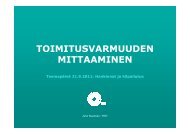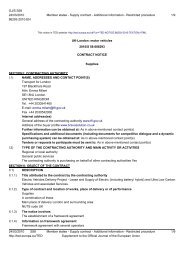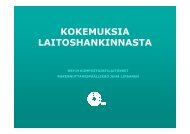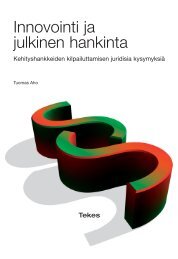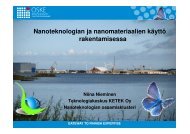Life cycle costing (LCC) as a contribution to sustainable construction ...
Life cycle costing (LCC) as a contribution to sustainable construction ...
Life cycle costing (LCC) as a contribution to sustainable construction ...
You also want an ePaper? Increase the reach of your titles
YUMPU automatically turns print PDFs into web optimized ePapers that Google loves.
Towards a common European methodology for <strong>Life</strong> Cycle Costing (<strong>LCC</strong>) – Guidance Document<br />
49<br />
<strong>LCC</strong> process<br />
Objective<br />
Preliminary<br />
identification<br />
of parameters<br />
and analysis<br />
requirements<br />
Confirmation<br />
of project and<br />
facility<br />
requirements<br />
Assembly of<br />
cost and<br />
performance<br />
data<br />
<strong>LCC</strong> analysis<br />
and results<br />
Auxiliary<br />
analyses (risk<br />
and sensitivity)<br />
Interpretation<br />
and reporting<br />
The main objective w<strong>as</strong> <strong>to</strong> budget an option which w<strong>as</strong> developed at the pre-detail design stage. This initial<br />
budgeting exercise w<strong>as</strong> subject <strong>to</strong> verification at later stages <strong>as</strong> <strong>to</strong> whether the rent will cover the actual<br />
annual costs, or whether the Direc<strong>to</strong>rate is likely <strong>to</strong> make a profit or loss on the project.<br />
Selected choices regarding the structure and M&E system were made b<strong>as</strong>ed on experience and p<strong>as</strong>t cost<br />
data for similar projects throughout the preliminary design stages.<br />
The scope of the analysis involved the <strong>to</strong>tal <strong>as</strong>set and all the stages of facility’s life (no disposal costs).<br />
The appraisl period w<strong>as</strong> set <strong>to</strong> 40 year <strong>as</strong> instructed by the project owner. The recommended appraisal<br />
period of a new build w<strong>as</strong> 60 years (public buildings). This h<strong>as</strong> <strong>to</strong> be taken in<strong>to</strong> account when comparing <strong>to</strong><br />
best practise (benchmarking). Calculations for an appraisal peroid of 60 years w<strong>as</strong> also done for<br />
comparison.<br />
The methods of the economic evaluation required by the client were NPV only and this is the main<br />
calculation method in the software LCProfit which supports the NS 3454 – Annual Costs for Buildings.<br />
"Holte Byggsafe" which publish the "Holte FDV" datab<strong>as</strong>e, is a well established firm in Norway that<br />
developes calculation <strong>to</strong>ols for the building industry <strong>as</strong> well <strong>as</strong> datab<strong>as</strong>es with building and cost data. FDVU<br />
is the Norwegian acronym for MOMD (management, operational, maintenance and development). Their<br />
product/cost datab<strong>as</strong>es do not contain the environmantal performance data (LCA), therefore the<br />
environmental considerations were reduced <strong>to</strong> benchmarking the energy use against best practise and the<br />
new requirement on energy use in buildings (<strong>as</strong> of 01.01.2007).<br />
The facility’s requirements were selected among the design team <strong>to</strong> optimise client’s requirements for the<br />
hospital building with the purpose of holding a psychiatric ward with capacity for 75 patients (of which a<br />
capacity of 15 patients on day-and-night care, and the rest poly-clinical). As this w<strong>as</strong> an additional building <strong>to</strong><br />
an existing hospital complex the <strong>as</strong>set’s requirements had <strong>to</strong> take in<strong>to</strong> account fitting in<strong>to</strong> the existing<br />
complex not only architecturally but also from services perspective. All structural elements and services were<br />
confirmed, including the external are<strong>as</strong> and parking lots, by the building’s tenant.<br />
The choice of HVAC systems w<strong>as</strong> a trade-off between current environmental performance, cost and<br />
possibility of future replacements with a more efficient system. The energy use w<strong>as</strong> also compared <strong>to</strong><br />
existing statistics and the requirements in the revised law on energy use in buildings <strong>as</strong> a result of the new<br />
EU directive on energy use in buildings. It w<strong>as</strong> suggested <strong>to</strong> the client that a more thorough energy<br />
calculation should be carried out, <strong>as</strong> well <strong>as</strong> a second <strong>LCC</strong> analysis with a building solution with better/more<br />
insulation, low energy lighting system and focus on building details.<br />
Project requirements – there w<strong>as</strong> a fixed budget of 107.8 million NOK and the options were selected<br />
according <strong>to</strong> their prices during the design stages. The site constraints and project constraints were agreed<br />
and acted upon between the client and the design team. The quality and performance requirements had <strong>to</strong><br />
correspond <strong>to</strong> Norwegian standards for hospitals.<br />
Annual costs were calculated according <strong>to</strong> NS 3454. The capital cost w<strong>as</strong> expected <strong>to</strong> be higher than best<br />
practise. The MOMD-cost may be higher/lower depending on the chosen solutions. Capital costs<br />
(investment costs) are only part of the annual costs <strong>as</strong>sociated with owning, operating and maintaining a<br />
building. MOM costs comprise 35-50% of the <strong>to</strong>tal annual costs of Statsbygg’s buildings, meaning they have<br />
a significant impact on rents.<br />
The discount rate w<strong>as</strong> selected according <strong>to</strong> the recommendation from the "Norwegian government<br />
calculation committee" (simular <strong>to</strong> the Tre<strong>as</strong>ury Green Book) and set <strong>as</strong> 6% (<strong>to</strong> be confirmed if real/nominal).<br />
Replacement timings for the <strong>as</strong>sets were <strong>as</strong>sessed using a combination of Ramboll’s own datab<strong>as</strong>e and the<br />
"Holte FDV" datab<strong>as</strong>e.<br />
The residual value w<strong>as</strong> not taken in<strong>to</strong> account, <strong>as</strong> this h<strong>as</strong> not been practised in public projects so far.<br />
An external risk register w<strong>as</strong> produced by the design team; however it w<strong>as</strong> not directly linked <strong>to</strong> the <strong>LCC</strong>.<br />
All the financial parameters were applied uniformly <strong>to</strong> all cost groups. LCProfit w<strong>as</strong> used <strong>as</strong> calculating <strong>to</strong>ol.<br />
The results were presented <strong>to</strong> the owner in a report in accordance with NS 3454 with recommendations for<br />
further analysis and conclusions.<br />
There are no calculation capabilities within LCProfit for risk or sensitivity analyses and the client h<strong>as</strong> not<br />
requested a separate one.<br />
Results included the outputs from the LCProfit, providing the following information: tables of costs,<br />
parameters of the analysis, annual expenditure and detailed cost profile. The formal report <strong>to</strong> the client w<strong>as</strong><br />
structured according <strong>to</strong> LCProfit’s outputs and guidance from NS 3454 but essentially it contained all the<br />
information which w<strong>as</strong> e<strong>as</strong>y <strong>to</strong> adjust <strong>to</strong> follow <strong>to</strong> the headings in ISO 15686 – Part 5.<br />
Davis Langdon Management Consulting May 2007



